I. Introduction
A. Overview of Thai cuisine
B. History and origin of Thai food
II. Key ingredients
A. Rice
B. Noodles
C. Herbs and Spices
D. Seafood and Meat
III. Popular Thai Dishes
A. Pad Thai
B. Tom Yum Soup
C. Green Curry
D. Massaman Curry
E. Papaya Salad
IV. Street Food in Thailand
A. Description of street food culture
B. Must-try street food dishes
C. Best places to try street food in Thailand
V. Drinks in Thailand
A. Thai iced tea and coffee
B. Fruit shakes
C. Alcoholic beverages
VI. Conclusion
A. Final thoughts on Thai cuisine
B. Encouragement to try Thai food
C. Additional resources for further exploration of Thai cuisine
I. Introduction
A. Overview of Thai cuisine
Thai cuisine is the culinary tradition of Thailand and reflects the country's cultural heritage and history. It is a unique and diverse style of cooking that combines sweet, sour, salty, and spicy flavors to create aromatic and delicious dishes. Thai cuisine has been influenced by various neighboring countries such as China, India, and Indonesia, and also by the use of local ingredients.
The staple food in Thailand is rice, which is usually served with various dishes such as curries, stir-fries, and soups. Thai cooking emphasizes using fresh ingredients, including herbs and spices, to add flavor and aroma to dishes. Common ingredients used in Thai cuisine include lemongrass, ginger, garlic, coriander, cumin, chili peppers, and fish sauce.
Thai cuisine is known for its wide range of dishes that vary in taste, aroma, and texture. Some popular Thai dishes include Pad Thai, Tom Yum Soup, Green Curry, Massaman Curry, and Papaya Salad. These dishes are delicious and visually appealing, often incorporating colorful ingredients and presented beautifully.
Thai food is also known for its use of street food, with vendors selling delicious and inexpensive dishes from carts and stalls. Street food in Thailand offers a unique experience for visitors and is a great way to sample various dishes.
Overall, Thai cuisine offers a unique and diverse range of dishes that are sure to please the palate of any food lover. So whether you're looking for a spicy curry, a fresh salad, or a sweet dessert, Thai food has something to offer. The use of fresh ingredients and bold flavors make Thai cuisine a must-try for anyone who loves good food.
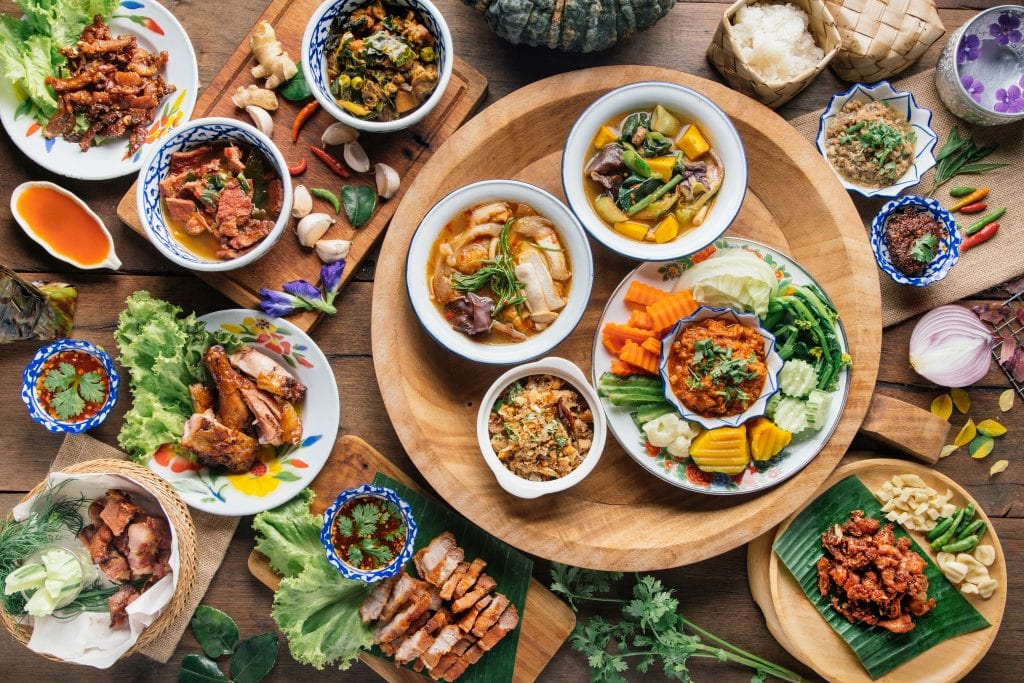
B. History and origin of Thai food
The history and origin of Thai food are closely tied to Thailand's cultural and historical development as a country. Thailand has a long history of immigration, trade, and cultural exchange, and these influences have shaped the country's cuisine over time.
Thai cuisine can be traced back to the 13th century when the first Thai kingdom was established in Sukhothai. During this time, the cuisine was influenced by Chinese and Indian cooking styles, and ingredients such as chili peppers, lemongrass, and coconut milk were introduced to Thai cooking.
The cuisine evolved as the Thai kingdom expanded and incorporated new ingredients and cooking styles. During the Ayutthaya period (1351-1767), trade with other Southeast Asian countries, China, and Europe brought fresh spices and cooking techniques to Thailand. This period saw the development of many famous Thai dishes, including Tom Yum Soup and Massaman Curry.
In the 19th and early 20th centuries, Thailand experienced a period of modernization and westernization, significantly impacting Thai cuisine. Western ingredients, such as sugar and canned goods, were introduced to Thai cooking, and the country's street food culture began to flourish.
Today, Thai cuisine is a unique and diverse style of cooking that incorporates flavors and ingredients from various cultures. Despite its long and complex history, Thai food remains a beloved part of Thai culture and continues to evolve and adapt to changing tastes and trends.
In conclusion, the history and origin of Thai food is a rich and complex tapestry woven from the threads of Thai history, cultural exchange, and immigration. The result is a unique and delicious cuisine that continues to be enjoyed by people all over the world.
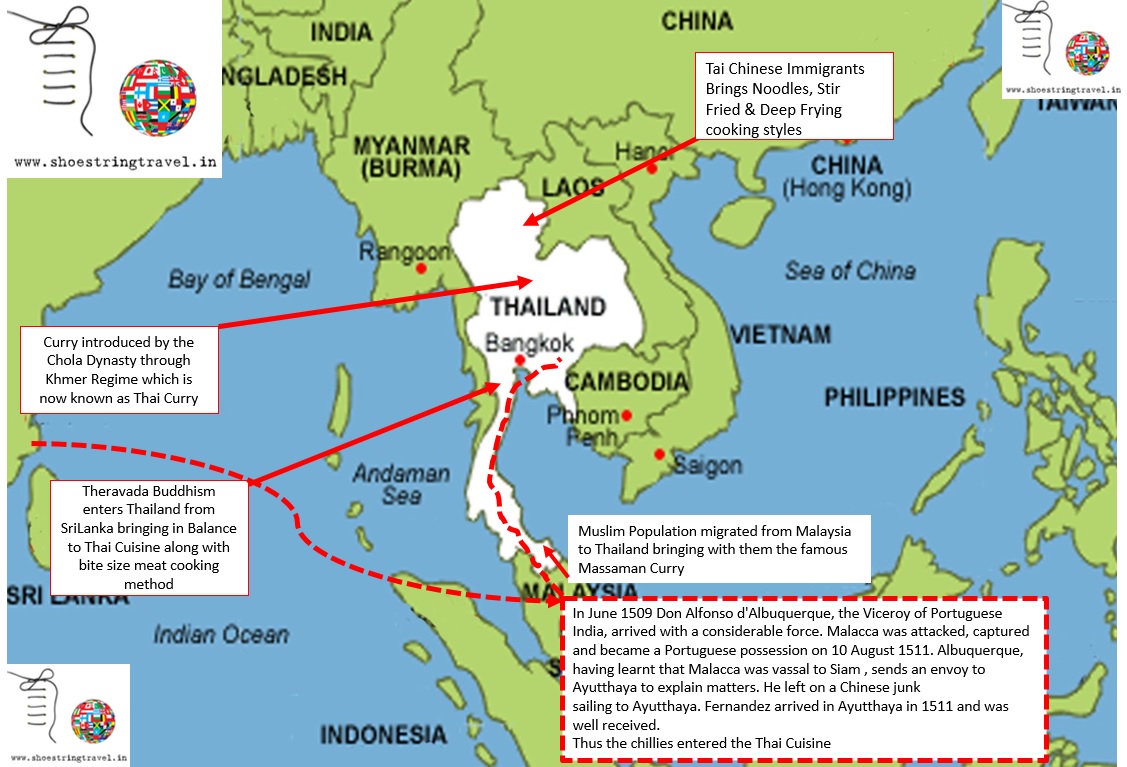
II. Key ingredients
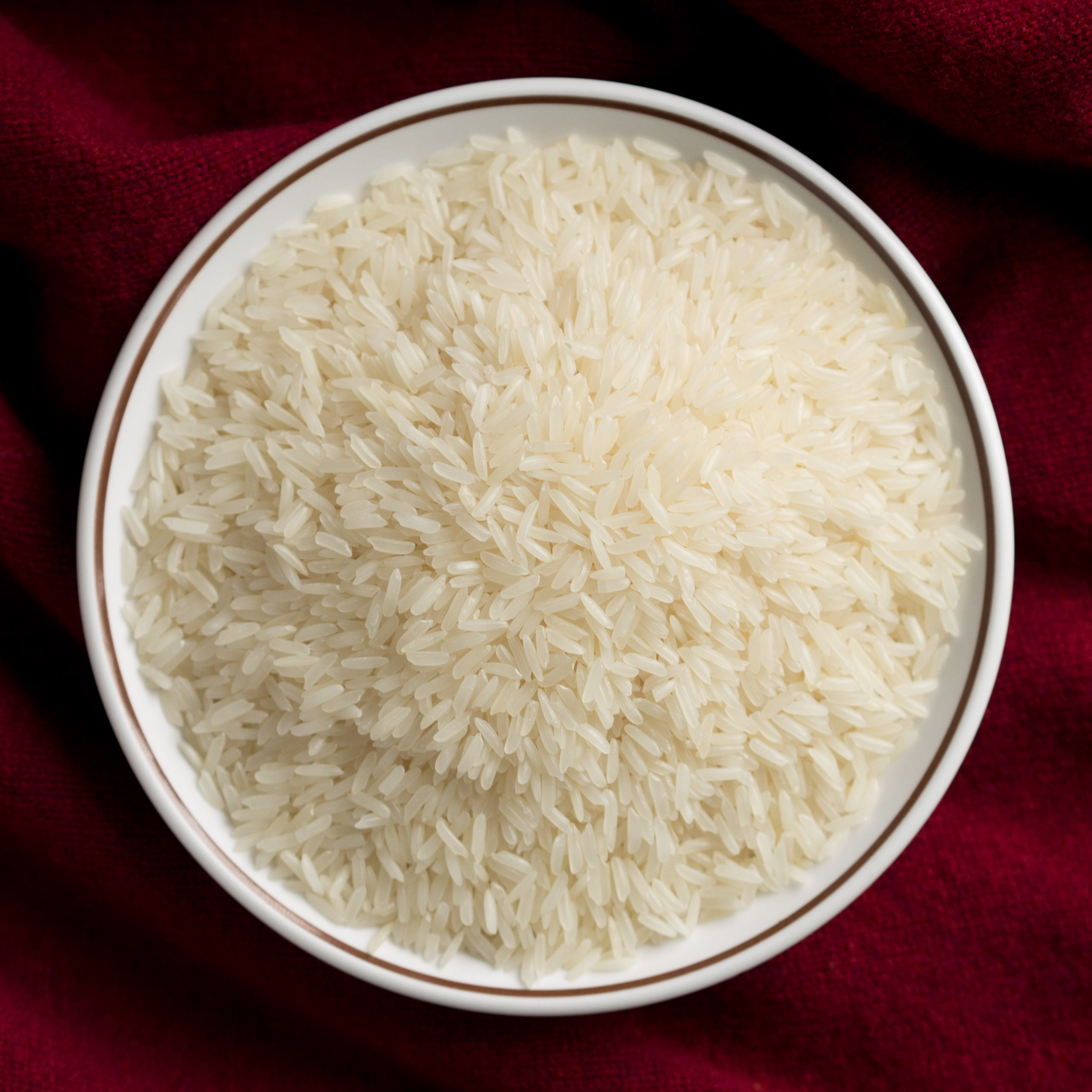
A. Rice
Rice is a staple food in Thailand and is an essential component of Thai cuisine. The word for "to eat" in Thai is "kin khao," which means "to eat rice." Therefore, rice is usually served with every meal and is a blank canvas upon which the flavors of other dishes can be showcased.
Several types of rice are commonly used in Thai cooking, including jasmine rice, sticky rice, and glutinous rice. Jasmine rice is the most popular rice in Thailand and is a fragrant, long-grain rice that is often used in savory dishes. Sticky rice, also known as glutinous rice, is a short-grain rice often used in sweet words and is a staple food in northern Thailand.
Rice is prepared in a variety of ways in Thai cuisine. It can be steamed, boiled, fried, or baked and is often used as the base for dishes such as Pad Thai and Green Curry. Rice can also be served as a side dish and is sometimes mixed with herbs, spices, and other ingredients to create dishes like pineapple fried rice or basil fried rice.
In addition to its role as a staple food, rice is also an essential part of Thai culture. Rice is seen as a symbol of wealth and prosperity and is often offered as a gift or used to make offerings to the gods. Rice is also an important crop in Thailand, and the country is one of the largest rice exporters in the world.
In conclusion, rice is an important and versatile food in Thai cuisine and integral to the country's culture and history. Whether served as a side dish, used as the base for a delicious dish, or offered as a symbol of prosperity, rice is a beloved and essential food in Thailand.

B. Noodles
Thai noodles are a staple food in Thai cuisine and essential to the country's culinary heritage. Several types of noodles are used in Thai cooking, including rice noodles, egg noodles, and glass noodles, and they are used in various dishes, such as stir-fries, soups, and salads.
Rice noodles, also known as "sen" in Thai, are the most commonly used type of noodle in Thai cuisine. They come in different shapes and sizes, including thin vermicelli, wide flat, and round noodles. Rice noodles are used in dishes such as Pad Thai, Phat Si Io, and Tom Yum Soup.
Egg noodles, also known as "ba mee," are another common type in Thai cooking. They are made from wheat flour, eggs, and salt and are often used in stir-fries and soups. One of the most popular dishes using egg noodles is the spicy noodle soup called "Guay Tiew Tom Yum."
Glass noodles, also known as "wun sen" in Thai, are made from mung bean flour and are translucent when cooked. They are often used in salads, such as the famous "Yum Wun Sen" dish, and can also be added to stir-fries and soups.
Thai noodles are delicious and a vital part essential culture. Noodle dishes are commonly sold at street stalls and served in homes and restaurants, and they offer a convenient and delightful way to enjoy Thai flavors.
In conclusion, Thai noodles are a staple food in Thai cuisine and essential to the country's cultural heritage. Whether they are used in stir-fries, soups, or salads, Thai noodles offer a delicious and versatile way to enjoy the flavors of Thailand.
C. Herbs and Spices
Herbs and spices play a significant role in Thai cuisine, providing bold and complex flavors. They add depth, aroma, and heat to dishes and are carefully combined to create unique flavor profiles distinctive to Thai cooking.
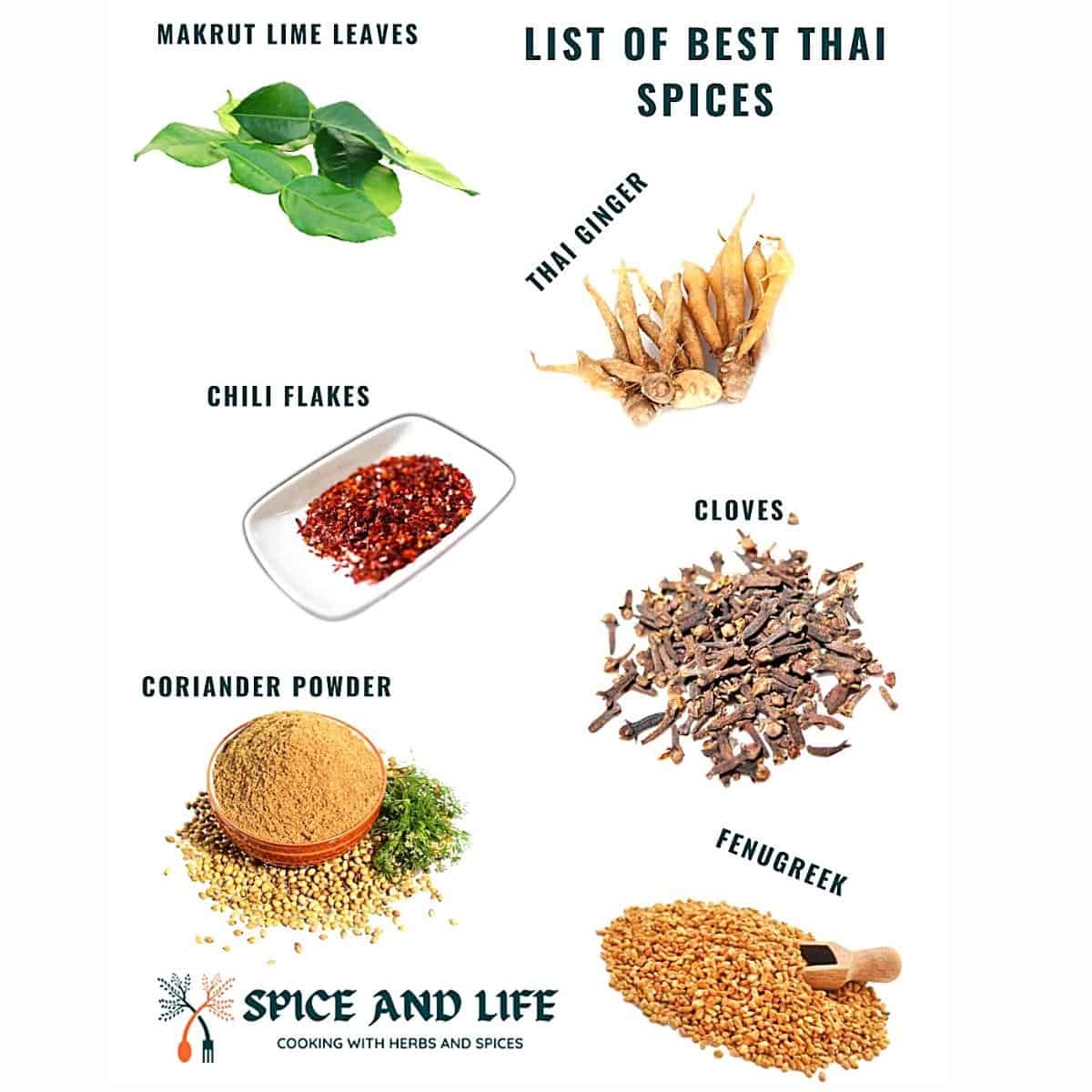
Some of the most commonly used herbs in Thai cuisine include basil, cilantro, mint, lemongrass, and kaffir lime leaves. Basil, both holy basil and Thai basil, is used to add a sweet, anise-like flavor to dishes and is often used in stir-fries and soups. Cilantro is used for its fresh, slightly citrusy flavor and is often used as a garnish or added to dipping sauces. Mint is used for its excellent and refreshing taste and is often used in salads and stir-fries. Lemongrass is used for its lemon-like flavor and often infuses soups and curries with its distinct aroma. Kaffir lime leaves are used for their unique citrusy flavor and aroma and are often used to flavor curries and soups.
In terms of spices, Thai cuisine is known for its use of chili peppers, which provide the heat that is a hallmark of cooking. Other commonly used herbs include coriander, cumin, turmeric, and galangal. Coriander is used for its warm, earthy flavor and is often used in spice blends and curries. Cumin is used in spice blends and soups for its pleasant and slightly bitter taste. Turmeric is used for its warm, earthy flavor and vibrant yellow color and is often used in curries and spice blends. Finally, Galangal is a type of ginger used for its slightly sweet, slightly bitter flavor and is often used in soups and curries.
In conclusion, herbs and spices are an essential part of Thai cuisine, providing the bold and complex flavors characteristic of the cuisine. They are combined to create unique flavor profiles that make Thai cooking distinctive and delicious.
D. Seafood and Meat
Seafood and meat are essential to Thai cuisine and are used in various dishes to provide protein and flavor. Seafood is abundant in Thailand due to its proximity to the ocean, and it is used in many words, including stir-fries, soups, and curries. Fish, shrimp, and crab are some of the most commonly used seafood in Thai cooking.
Meat is also a staple ingredient in Thai cuisine, and chicken, beef, pork, and duck are commonly used. Thai cooking often uses thinly sliced meat that is stir-fried or grilled, and it is often paired with herbs and spices to create bold and complex flavor profiles. Some of the most popular Thai dishes that feature meat include Pad Thai, Massaman Curry, and Tom Yum Soup.
In terms of cooking techniques, Thai cuisine often uses grilling, stir-frying, and boiling to prepare seafood and meat. Grilling is a common cooking technique in Thailand, and seafood and meat are usually grilled over high heat to add flavor and caramelization. Stir-frying is another popular cooking technique in Thai cuisine, and it is often used to quickly cook thinly sliced meat and seafood with herbs and spices. Boiling is also commonly used in Thai cooking, and seafood and meat are often boiled to make soups and broths.
In conclusion, seafood and meat are essential to Thai cuisine, providing protein and flavor to various dishes. They are often prepared using grilling, stir-frying, and boiling techniques and are paired with herbs and spices to create bold and complex flavor profiles.
III. Popular Thai Dishes
A. Pad Thai
Pad Thai is one of the most popular Thai dishes and is widely recognized as a signature dish of Thai cuisine. It is a stir-fried noodle dish with rice noodles, vegetables, protein, and a flavorful sauce.
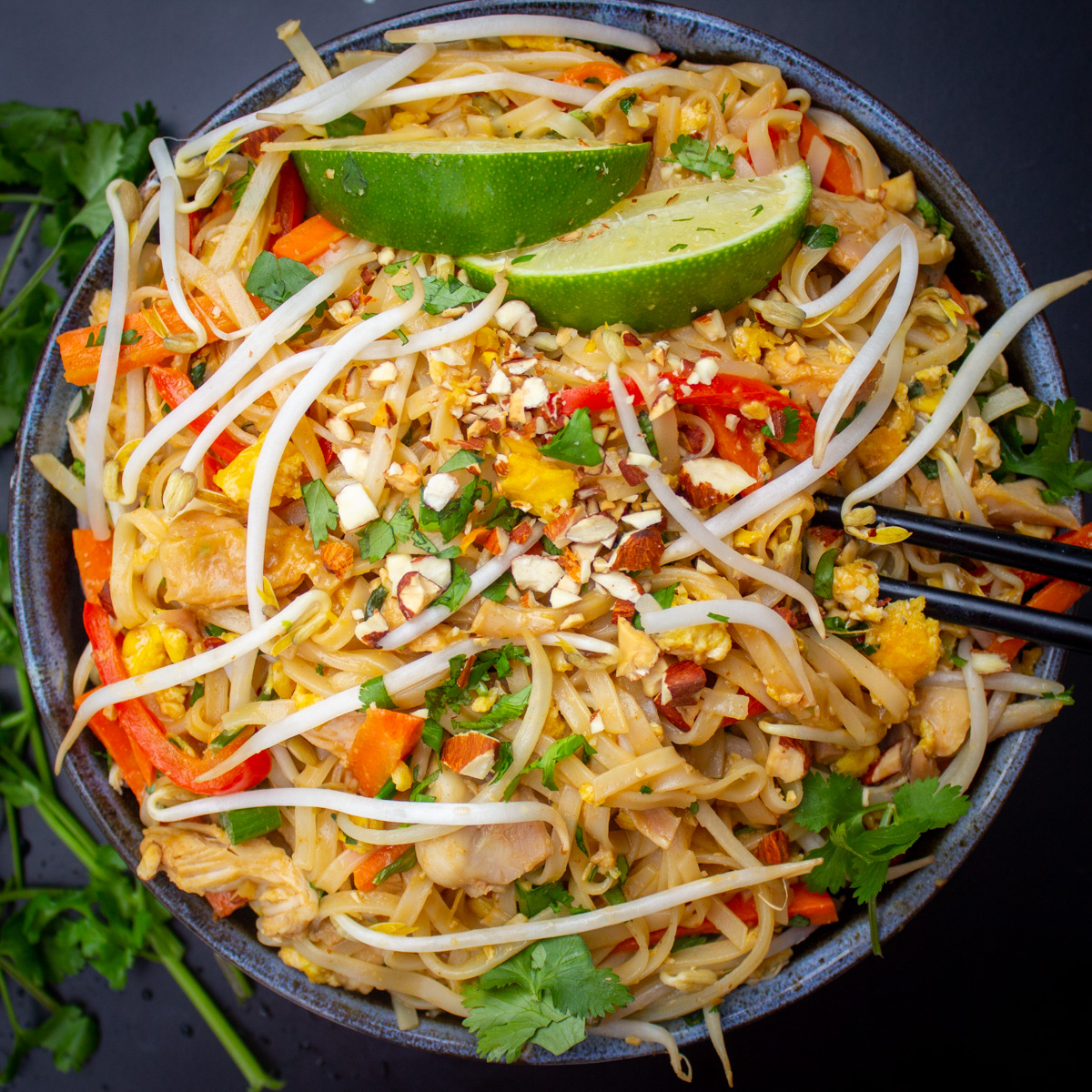
The dish is believed to have originated in the 1930s and 1940s when the Thai government was promoting nationalism and encouraging the use of Thai ingredients in cooking. As a result, pad Thai was created to showcase Thai ingredients, quickly becoming popular in Thailand and worldwide.
The essential ingredients in Pad Thai include rice noodles, protein (such as chicken, shrimp, or tofu), vegetables (such as bean sprouts, carrots, and peanuts), and a sauce made from ingredients such as tamarind, palm sugar, fish sauce, and chili pepper. The noodles and ingredients are stir-fried together in a wok over high heat, and the sauce is added to create a flavorful and slightly sweet, sour, and spicy dish.
There are many variations of Pad Thai, and the ingredients can be adjusted to suit individual tastes. Some variations include adding eggs, different types of protein, and spices or herbs. In addition, pad Thai is often served with lime wedges and chopped peanuts, which add freshness and crunch to the dish.
In conclusion, Pad Thai is a famous and beloved Thai dish with rice noodles, vegetables, protein, and a flavorful sauce. It is a staple of Thai cuisine, and its popularity has made it a well-known dish worldwide. With its combination of sweet, sour, and spicy flavors, and its versatility in terms of ingredients, Pad Thai is a delicious and satisfying dish that continues to be enjoyed by people worldwide.
B. Tom Yum Soup
Tom Yum Soup is a famous and flavorful Thai soup known for its bold and complex taste. It is a hot and sour soup with a broth flavored with lemongrass, kaffir lime leaves, galangal, chilies, and other herbs and spices.
The soup is typically made with a clear broth, but it can also be made with a creamy coconut milk base. The broth is then combined with ingredients such as shrimp, chicken, mushrooms, and vegetables, and the soup is finished with a squeeze of fresh lime juice and cilantro.
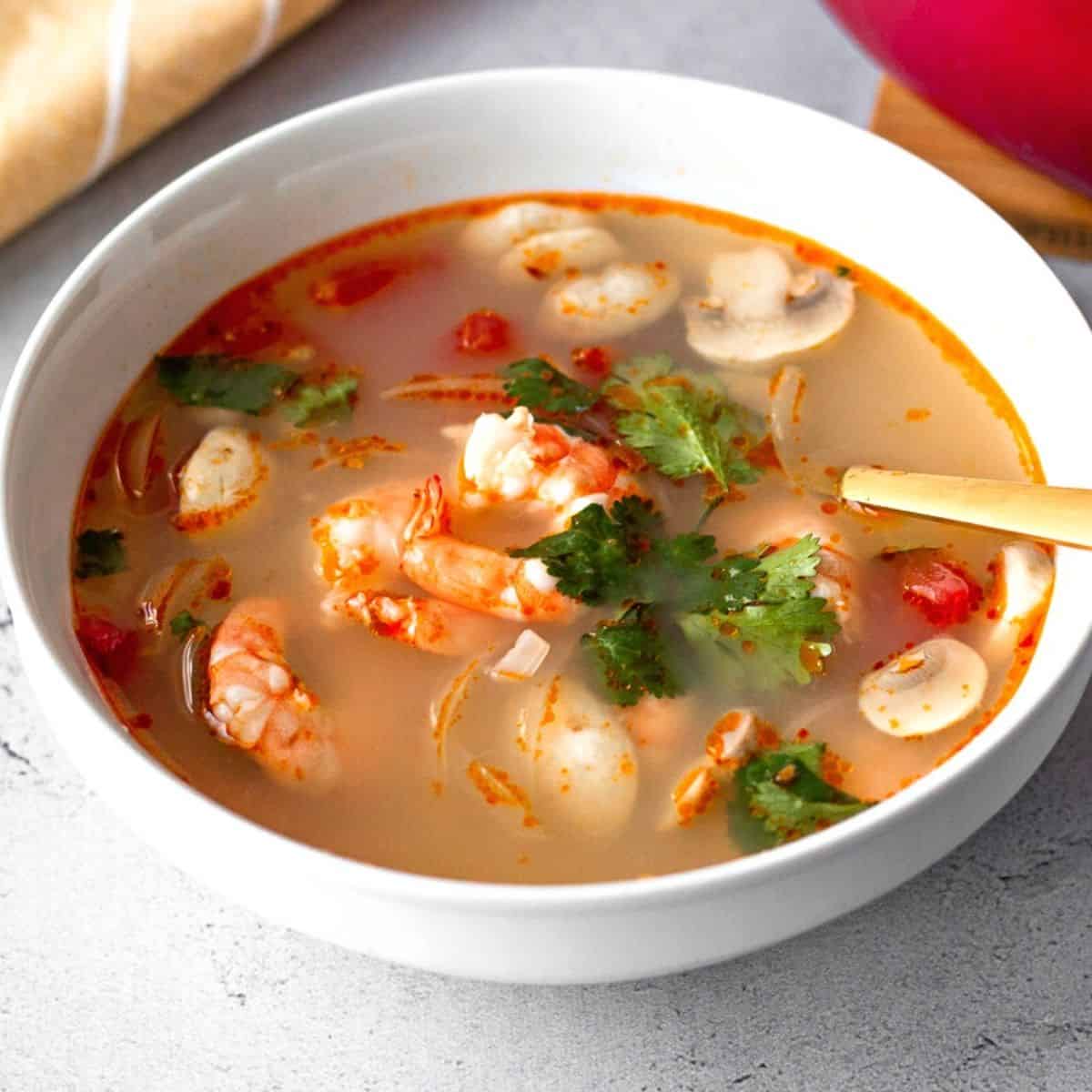
Tom Yum Soup is believed to have originated in Thailand and is considered a national dish. The soup is famous both in Thailand and worldwide, and its combination of sour, spicy, and herbal flavors makes it a distinctive and memorable dish.
In terms of preparation, Tom Yum Soup is typically made by simmering the broth ingredients until the flavors are fully developed. The broth is then strained, and the remaining ingredients are added. The soup is then simmered until the protein is cooked and the flavors have fully melded together.
Tom Yum Soup is often served as a starter, but it can also be a main course. The soup can be adjusted in terms of spiciness to suit individual tastes, and it can be made with various proteins and vegetables.
In conclusion, Tom Yum Soup is a famous and flavorful Thai soup known for its bold and complex taste. Made with a broth flavored with lemongrass, kaffir lime leaves, galangal, and other herbs and spices, Tom Yum Soup is a hot and sour soup that is beloved by people all over the world. Whether served as a starter or a main course, Tom Yum Soup is a delicious and satisfying dish that is sure to please.
C. Green Curry
Green Curry is a popular and flavorful Thai dish known for its bold and spicy taste. It is a Thai curry made with green chili paste and coconut milk and is often served with rice.
The green chili paste used in Green Curry is made from a blend of green chilies, shallots, garlic, lemongrass, galangal, and other herbs and spices. This paste is combined with coconut milk to create a rich and flavorful sauce, and the sauce is then combined with ingredients such as chicken, beef, or vegetables. The dish is typically finished with a squeeze of fresh lime juice and cilantro and is often served with steamed rice.
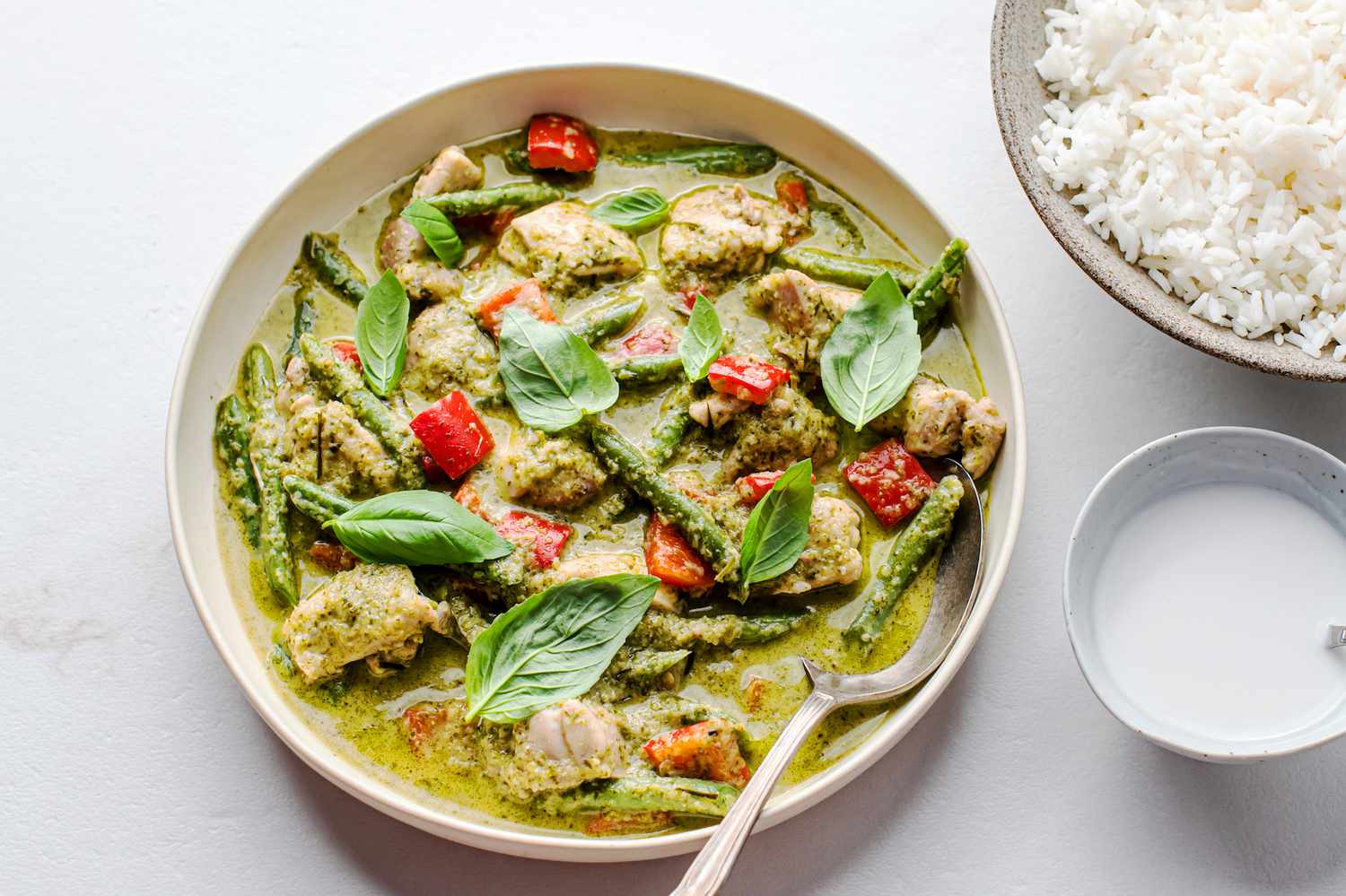
Green Curry is believed to have originated in Thailand and is considered one of the country's national dishes. The dish is popular both in Thailand and worldwide, and its bold and spicy flavor profile has made it a staple of Thai cuisine.
In terms of preparation, Green Curry is typically made by first creating the green chili paste. The paste is then simmered in a pan with coconut milk until the flavors have fully melded together. Next, the ingredients are added, and the dish is simmered until the protein is cooked and the flavors fully develop.
Green Curry can be adjusted in terms of spiciness to suit individual tastes and can be made with various proteins and vegetables. It is a versatile dish that can be served as a main course and is often enjoyed for its rich and spicy flavor profile.
In conclusion, Green Curry is a popular and flavorful Thai dish known for its bold and spicy taste. Made with a green chili paste and coconut milk, Green Curry is a type of Thai curry that is typically served with rice. Whether enjoyed as a main course or as part of a larger Thai meal, Green Curry is a delicious and satisfying dish that is sure to please.
D. Massaman Curry
Massaman Curry is a rich and flavorful Thai curry known for its complex taste and sweet, nutty flavor profile. It is made with a blend of spices and seasonings, including chili peppers, cinnamon, cardamom, star anise, and cumin, and it is typically served with rice.
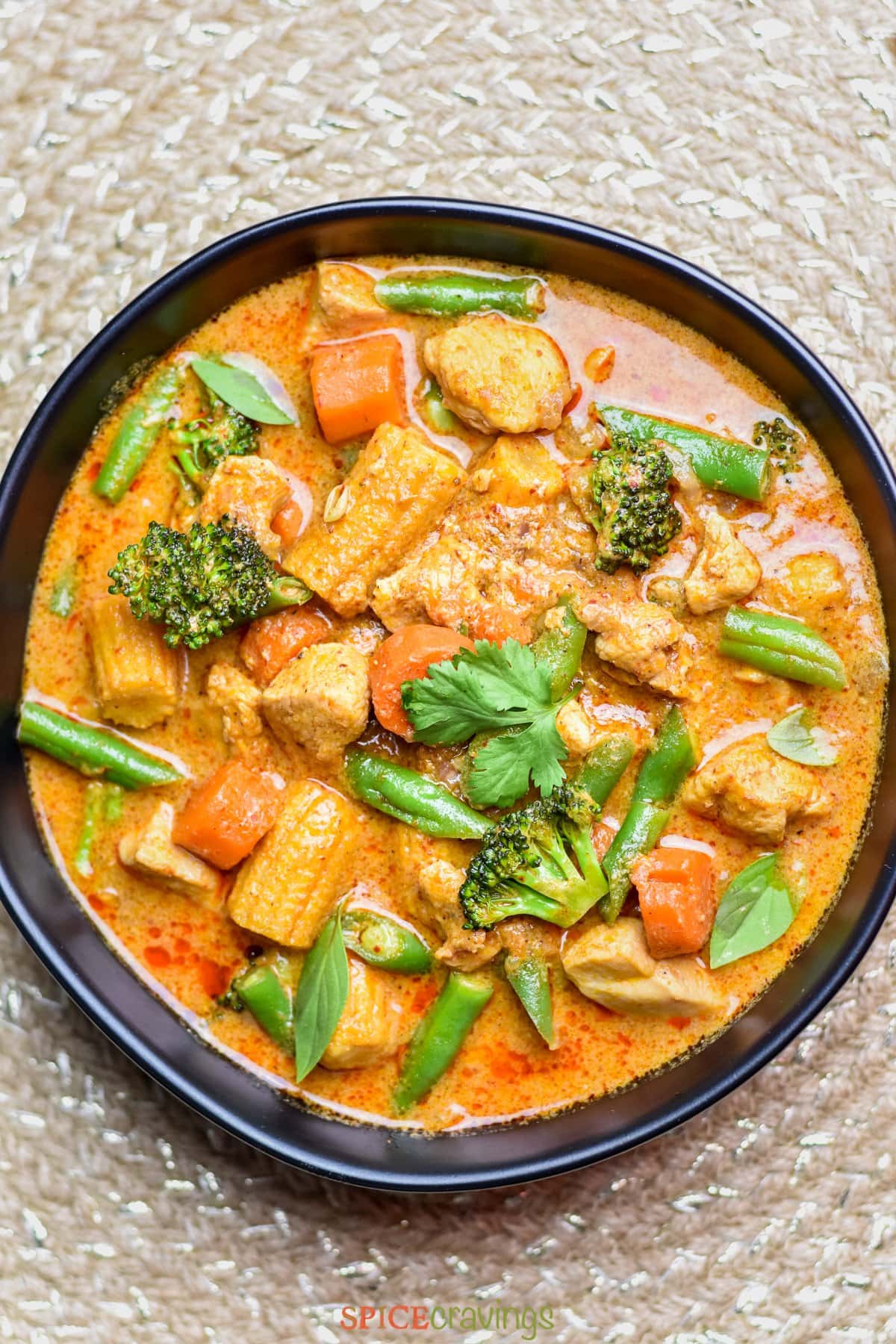
Massaman Curry is believed to have originated in Thailand and is considered one of the country's national dishes. The dish is made with a Massaman curry paste, a blend of spices and herbs cooked with coconut milk, peanuts, and other ingredients to create a rich and flavorful sauce. The sauce is then combined with ingredients such as beef, chicken, or vegetables, and the dish is finished with a squeeze of fresh lime juice and a sprinkle of chopped peanuts.
In terms of preparation, Massaman Curry is typically made by first creating the Massaman curry paste. The paste is then simmered in a pan with coconut milk until the flavors have fully melded together. Next, the ingredients are added, and the dish is simmered until the protein is cooked and the flavors fully develop.
Massaman Curry is considered a milder and sweeter version of Thai curry, and it is a popular choice for those who enjoy complex and nuanced flavors. The dish can be adjusted in terms of spiciness to suit individual tastes, and it can be made with various proteins and vegetables.
In conclusion, Massaman Curry is a rich and flavorful Thai curry known for its complex taste and sweet, nutty flavor profile. Massaman Curry is a delicious and satisfying dish that is sure to please, made with a blend of spices and seasonings and typically served with rice. Whether enjoyed as a main course or as part of a larger Thai meal, Massaman Curry is a flavorful and memorable dish that is loved by Thai food lovers worldwide.
E. Papaya Salad
Papaya Salad, also known as Som tum in Thai, is a popular and flavorful dish widely enjoyed in Thailand. It is a type of Thai salad that is made from shredded green papaya, and it is typically served as a side dish or a snack.
The main ingredient in Papaya Salad is shredded green papaya, which is combined with various other elements such as cherry tomatoes, garlic, long beans, peanuts, and chili peppers. The salad is dressed with a sauce made from palm sugar, lime juice, fish sauce, and chili peppers, and it is often finished with a sprinkle of chopped peanuts and a squeeze of fresh lime juice.
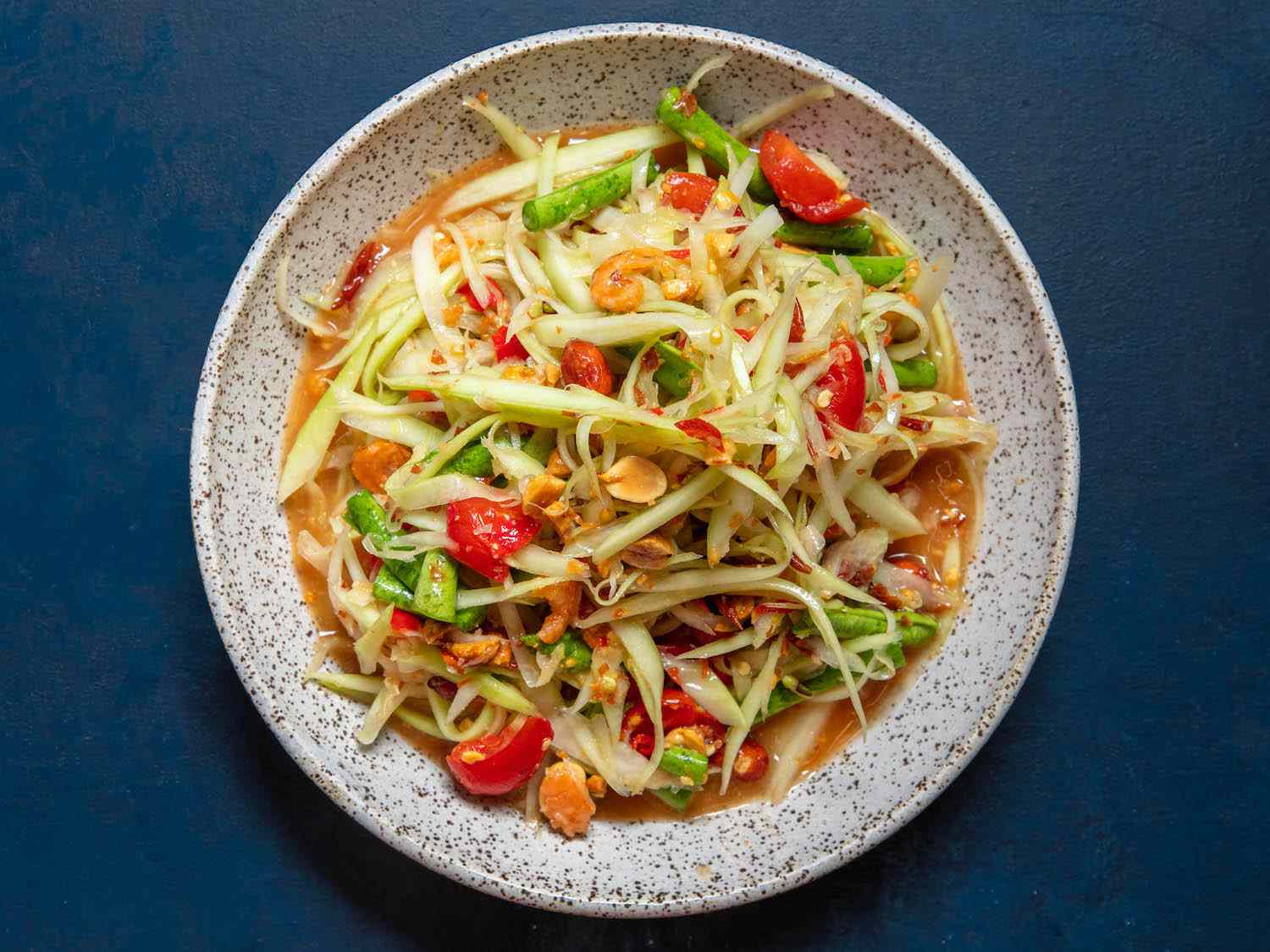
Papaya Salad is a versatile dish that can be adjusted in terms of spiciness to suit individual tastes, and it is a popular choice for those who enjoy bold and spicy flavors. The dish is typically served as a side dish but can also be enjoyed as a snack or as part of a larger Thai meal.
In terms of preparation, Papaya Salad is typically made by shredding the green papaya and combining it with other ingredients such as cherry tomatoes, garlic, and long beans. The dressing is then made by combining palm sugar, lime juice, fish sauce, and chili peppers, and the gravy is then poured over the shredded papaya and other ingredients. The salad is then finished with a sprinkle of chopped peanuts and a squeeze of fresh lime juice.
In conclusion, Papaya Salad is a popular and flavorful Thai dish widely enjoyed in Thailand. Made from shredded green papaya and dressed with a bold and spicy sauce, Papaya Salad is a delicious and satisfying side dish that is sure to please. Whether enjoyed as a snack or as part of a larger Thai meal, Papaya Salad is a flavorful and memorable dish that is loved by Thai food lovers worldwide.
IV. Street Food in Thailand
A. Description of street food culture
Thailand is well-known for its vibrant street food culture and is a major attraction for tourists and food lovers worldwide. Street food in Thailand is a way of life for many Thai people and is an integral part of the country's culture and cuisine.
Street food vendors can be found all over Thailand, especially in cities like Bangkok, Chiang Mai, and Phuket. They offer a wide range of dishes, including noodles, stir-fries, curries, soups, and snacks. Thailand's famous street food dishes include pad Thai, green curry, tom yum soup, and papaya salad.
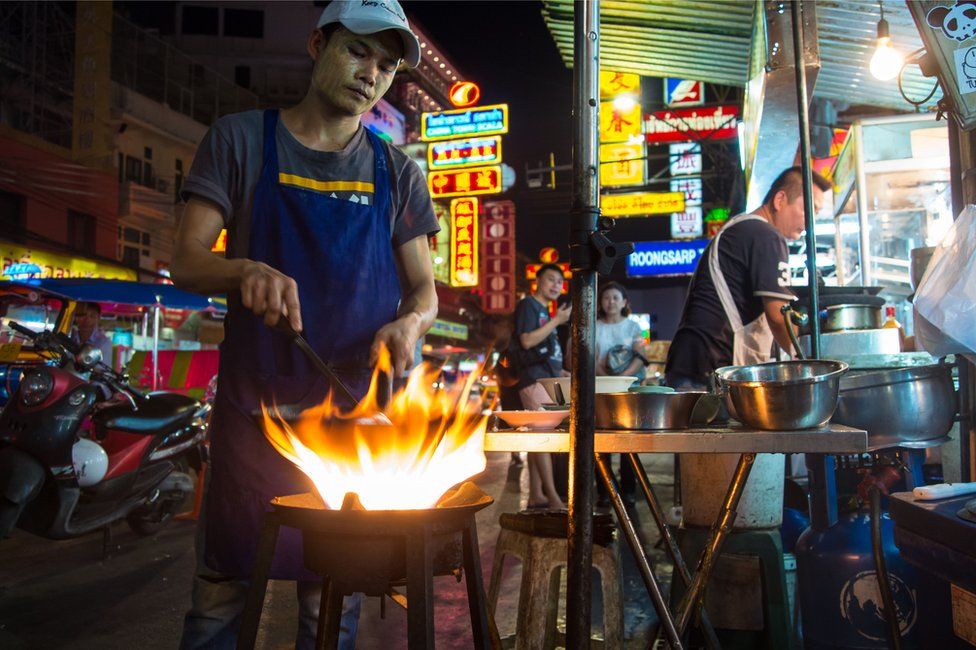
One of the unique aspects of Thailand's street food culture is the quality of the food. Despite the informal setting, street food vendors are held to high standards and are known for using fresh, high-quality ingredients in their dishes. They also take pride in their cooking techniques and in the flavors that they create.
Another aspect of street food culture in Thailand is the atmosphere. Street food vendors often set up their stalls on busy street corners, creating a lively and bustling atmosphere. In addition, the vendors are usually friendly and welcoming, offering a unique cultural experience for tourists and locals alike.
The street food culture in Thailand is also affordable, with most dishes costing between 30 to 60 Baht, equivalent to one to two US dollars. This makes street food an accessible and affordable option for many Thai people, and it is a popular way for locals to enjoy a delicious and satisfying meal.
In conclusion, Thailand's street food culture is a major attraction for tourists and food lovers worldwide. With its wide range of delicious dishes, high-quality ingredients, and vibrant atmosphere, street food in Thailand is an integral part of the country's culture and cuisine. Whether enjoyed as a quick snack or as a complete meal, street food in Thailand is a flavorful and memorable experience that is not to be missed.
B. Must-try street food dishes
Thailand is known for its vibrant street food culture; there are many must-try dishes for tourists and food lovers to sample. From noodle dishes and stir-fries to curries and snacks, the street food scene in Thailand offers a diverse range of delicious options. Here are some of the must-try street food dishes in Thailand:
Pad Thai: Pad Thai is a classic Thai noodle dish made with stir-fried noodles, vegetables, and a protein of choice, such as chicken, shrimp, or tofu. It is typically flavored with a sweet and tangy sauce and often topped with crushed peanuts, lime wedges, and cilantro.

Green Curry: Green Curry is a spicy Thai curry made with green chilies, coconut milk, and various herbs and spices. It is typically served with rice and a protein of your choice, such as chicken, beef, or tofu.
Tom Yum Soup: Tom Yum Soup is a famous Thai soup made with a spicy and sour broth, lemongrass, galangal, lime juice, and various herbs and spices. It is typically served with shrimp, but it can also be made with chicken or vegetables.
Papaya Salad: Papaya Salad, also known as Som tum, is a spicy Thai salad made from shredded green papaya, cherry tomatoes, garlic, long beans, peanuts, and chili peppers. It is dressed with a sauce made from palm sugar, lime juice, fish sauce, and chili peppers, and it is often finished with a sprinkle of chopped peanuts and a squeeze of fresh lime juice.
Mango Sticky Rice: Mango Sticky Rice is a sweet and satisfying dessert made from glutinous rice, mangoes, and a sweet sauce made from coconut milk and sugar. It is a popular street food dish in Thailand and is a must-try for anyone with a sweet tooth.
Fried Rice: Fried Rice is a classic Thai dish made with stir-fried rice, vegetables, and a protein of your choice, such as chicken, shrimp, or tofu. It is a filling and flavorful option for those looking for a quick and satisfying street food meal.
In conclusion, Thailand offers a wide range of delicious street food dishes for tourists and lovers. From classic dishes like Pad Thai and Green Curry to sweet treats like Mango Sticky Rice, there is something for everyone in Thailand's vibrant street food scene. Whether enjoyed as a quick snack or as a complete meal, street food in Thailand is a flavorful and memorable experience that is not to be missed.
C. Best places to try street food in Thailand
Thailand is known for its vibrant street food culture, and there are many excellent places to try street food in the country. Whether in Bangkok, Chiang Mai, or Phuket, there is always a street food scene nearby. Here are some of the best places to try street food in Thailand:
Bangkok: Bangkok is one of the world's most famous street food cities and a must-visit for anyone interested in Thai street food. Bangkok's best street food areas include Chatuchak Weekend Market, Yaowarat (Bangkok's Chinatown), and the street food stalls along Sukhumvit Road.
Chiang Mai: Chiang Mai is a vibrant and culturally rich city in northern Thailand and is famous for its street food scene. Some of the best street food areas in Chiang Mai include the night bazaar, the city's food courts, and the street food stalls around the city's many temples.
Phuket: Phuket is a tropical island paradise in southern Thailand known for its street food scene. Some of Phuket's best street food areas include the street food stalls along Patong Beach, the night markets, and the food courts in the city center.
Pattaya: Pattaya is a famous beach city in eastern Thailand known for its street food scene. Pattaya's best street food areas include the street food stalls along Walking Street, the night markets, and the food courts around the city center.
Chiang Rai: Chiang Rai is a culturally rich city in northern Thailand known for its street food scene. Some of the best street food areas in Chiang Rai include the night bazaar, the food courts around the city center, and the street food stalls around the city's many temples.
In conclusion, Thailand is a street food lover's paradise, and there are many excellent places to try street food in the country. Whether in Bangkok, Chiang Mai, Phuket, Pattaya, or Chiang Rai, you will find various delicious street food dishes to sample. So don't hesitate to explore the street food scene on your next trip to Thailand!
V. Drinks in Thailand
A. Thai iced tea and coffee
Thai iced tea and coffee are two popular beverages in Thailand that are enjoyed by both locals and tourists alike. These drinks are known for their unique flavors, refreshing taste, and cultural significance in Thai society.
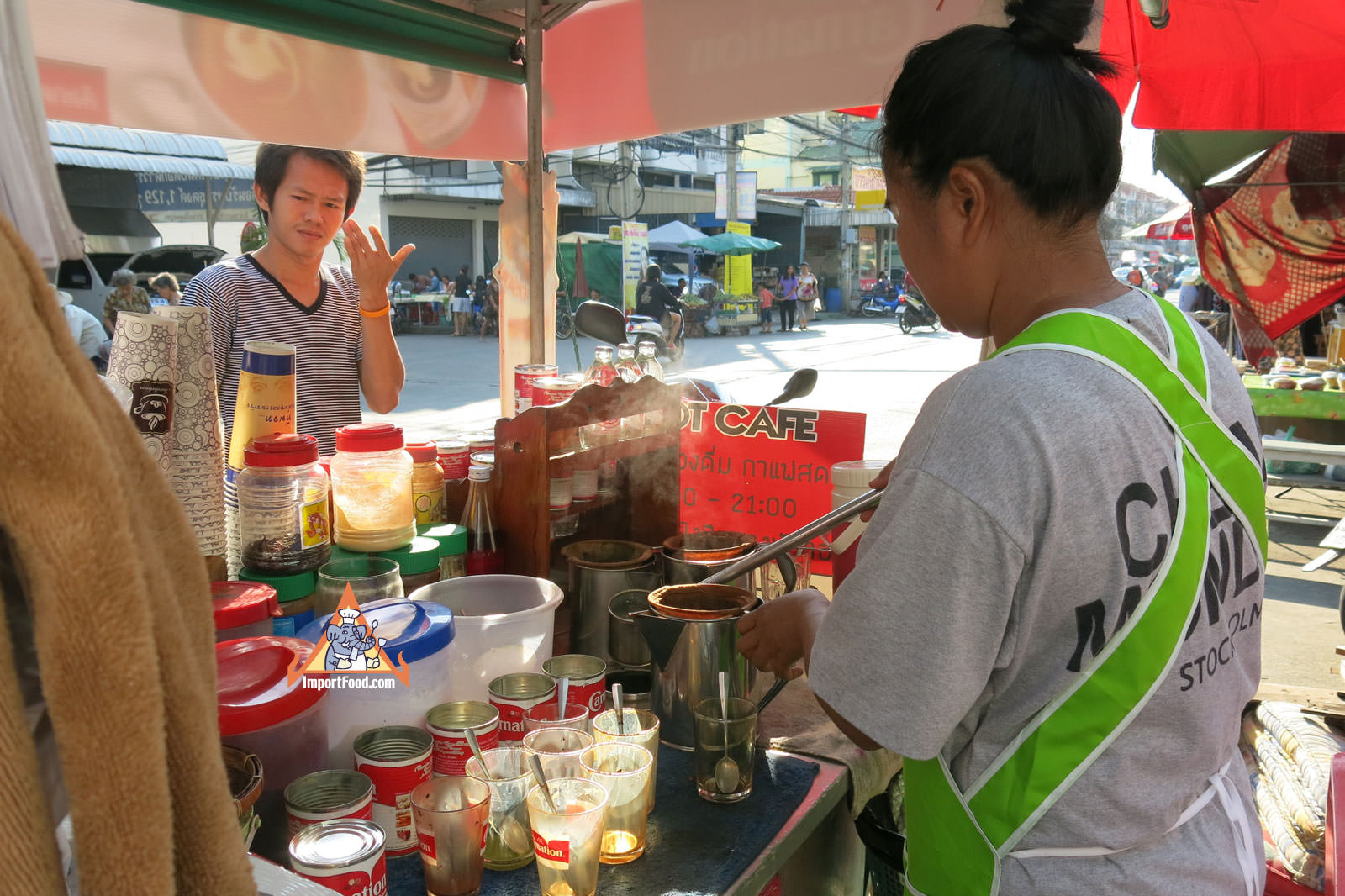
Thai Iced Tea: Thai iced tea, also known as "cha yen," is a sweet and creamy drink made from black tea leaves, milk, sugar, and spices such as star anise and cinnamon. The tea is brewed and combined with the other ingredients to create a rich, flavorful drink typically served over ice. Thai iced tea is a staple in Thai cuisine and can be found at street food stalls, cafes, and restaurants throughout the country.
Thai Coffee: Thai coffee, also known as "ka fee yen," is a strong and flavorful drink made from robusta coffee beans. The coffee is brewed with sugar and spices such as cardamom and cinnamon to create a sweet and aromatic drink. Thai coffee is often served over ice and is a popular beverage in Thai society, particularly in the morning or afternoon.
In conclusion, Thai iced tea and coffee are two popular beverages in Thailand that are enjoyed for their unique flavors and cultural significance. Whether you are a coffee or tea drinker, you will find a Thai iced tea or coffee that you will love during your travels in Thailand. So try these delicious drinks on your next trip to Thailand!
B. Fruit shakes
Fruit shakes, also known as "nam din," are a popular and refreshing drink in Thailand that locals and tourists enjoy. These drinks are made from fresh Fruit, ice, and sugar, blended to create a sweet and fruity drink that is perfect for a hot day.
Fruit shakes in Thailand come in a wide variety of flavors, including mango, pineapple, watermelon, papaya, and more. These drinks are widely available in Thailand and can be found at street food stalls, cafes, and restaurants throughout the country. They are typically sold for a low price and are a popular quick and refreshing snack option.
In addition to their delicious flavor, fruit shakes are also a healthy option, as they are made from fresh Fruit and are free of additives and preservatives. They are also a great way to stay hydrated in Thailand's hot and humid climate.
In conclusion, fruit shakes are a popular and refreshing drink in Thailand for their delicious flavor and health benefits. So whether you are looking for a quick and refreshing snack or a way to stay hydrated, try a fruit shake on your next trip to Thailand!

C. Alcoholic beverages
Thailand is known for its diverse range of alcoholic beverages, including traditional and imported options. The most popular alcoholic drinks in Thailand include beer, spirits, and cocktails.
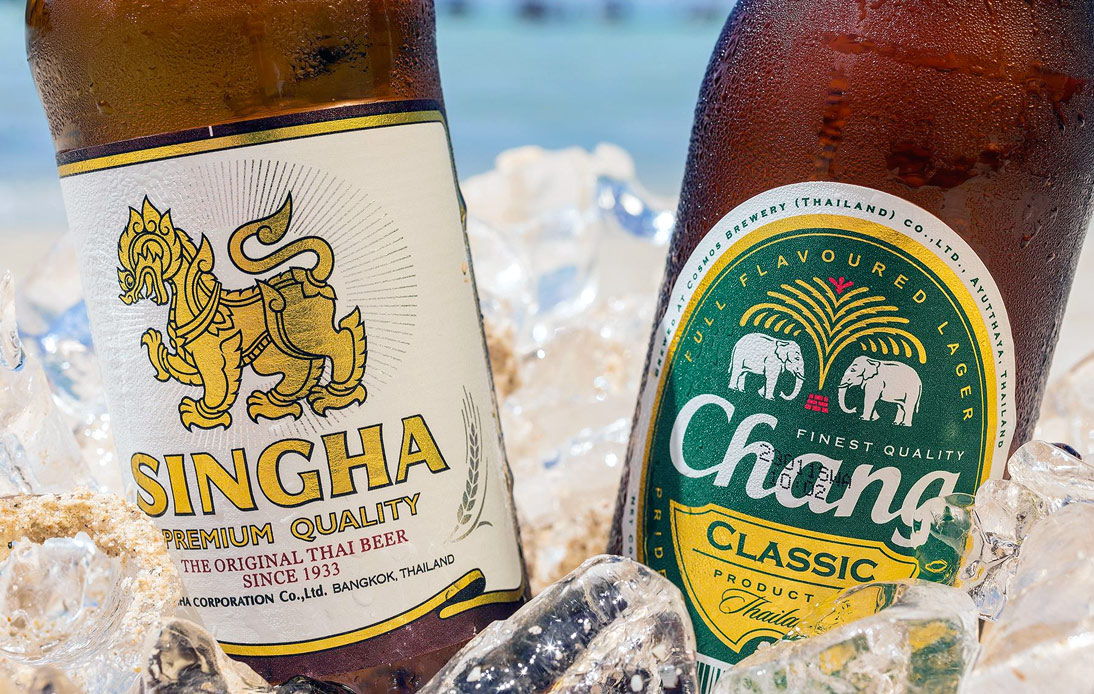
Beer: Beer is the most popular alcoholic drink in Thailand and is widely available at bars, nightclubs, and street vendors. The most popular beer brands in Thailand are Singha, Chang, and Leo, brewed locally. In addition to these famous brands, there is a growing craft beer scene in Thailand, with small breweries offering unique and flavorful beers.
Spirits: Spirits, such as whiskey, rum, and brandy, are also popular in Thailand and are widely available at bars and nightclubs. In addition to these traditional spirits, there is also a traditional Thai spirit called "Lao Khao" or "Rice whiskey," which is made from fermented rice and is a popular option for locals.
Cocktails: Cocktails are a popular option in Thailand and can be found at bars and nightclubs throughout the country. Popular cocktails in Thailand include the "Mai Tai," "Singapore Sling," and "Long Island Iced Tea." In addition to these traditional cocktails, many unique and creative cocktails are available in Thailand, made with local ingredients and flavors.
In conclusion, Thailand is known for its diverse range of alcoholic beverages, which include beer, spirits, and cocktails. So whether you are looking for a cold beer, a traditional nature, or a unique cocktail, you will find something to suit your tastes in Thailand. So be sure to try a few delicious and refreshing drinks on your next trip to Thailand!
VI. Conclusion
A. Final thoughts on Thai cuisine
Thai cuisine is a rich and diverse culinary tradition that is enjoyed by people all over the world. Thai food offers a taste experience with its unique blend of flavors and spices. From fragrant curries and savory stir-fries to spicy salads and fresh seafood dishes, there is something for everyone in Thai cuisine.
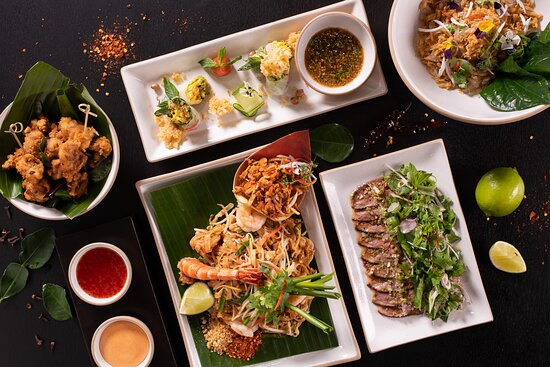
The history and culture of Thailand are evident in its food, which is influenced by the country's geographic location, religion, and regional traditions. The use of herbs and spices, such as lemongrass, kaffir lime leaves, and chili peppers, is a defining characteristic of Thai food and gives dishes a distinctive flavor that is bold and aromatic.
Thai street food is also a significant part of the country's culinary culture and is a must-try for anyone visiting Thailand. Thailand is a food lover's paradise with its delicious food stalls, vibrant street vendors, and bustling food markets. So whether you are looking for a quick and tasty snack or a sit-down meal, you will find something to satisfy your cravings in Thailand's street food scene.
In conclusion, Thai cuisine is a rich and diverse culinary tradition that offers a taste experience like no other. With its flavorful dishes, vibrant street food scene, and cultural significance, Thai cuisine is a true culinary gem that will delight and inspire food lovers everywhere. So be sure to experience the delicious flavors of Thai cuisine on your next trip to Thailand!
B. Encouragement to try Thai food
Thai food is a truly unique and delicious cuisine that is enjoyed by people all over the world. So whether you are a seasoned foodie or just a casual eater, Thai food has something to offer everyone.
The flavors of Thai food are bold and aromatic, with a perfect balance of sweet, salty, sour, and spicy. The use of fresh herbs and spices, such as lemongrass, kaffir lime leaves, and chili peppers, gives Thai food a distinctive flavor that is both complex and satisfying.
In addition to its delicious flavors, Thai food is also known for its health benefits. With its emphasis on fresh ingredients and flavorful spices, Thai food is a nutritious and satisfying option for those looking for a healthier alternative to traditional Western cuisine.
So why not give Thai food a try? Whether you are dining in a restaurant or trying street food in Thailand, there is sure to be a Thai dish that will satisfy your cravings. From fragrant curries and savory stir-fries to spicy salads and fresh seafood dishes, there is something for everyone in Thai cuisine.
In conclusion, Thai food is a delicious and healthy cuisine that is enjoyed by people all over the world. So why give it a try today? Whether a seasoned foodie or just a casual eater, you will find something to love in Thai cuisine. So go ahead and indulge in the bold and flavorful dishes of Thailand!
C. Additional resources for further exploration of Thai cuisine
Many resources offer valuable information and insights for those interested in further exploring Thai cuisine. Whether you are looking to learn more about the history and culture of Thai food, discover new recipes, or find the best Thai restaurants in your area, a wealth of information is available to help you delve deeper into Thai cuisine.
Here are some additional resources that can help you further explore Thai cuisine:
Cookbooks: Many cookbooks specialize in Thai cuisine, offering various recipes, cooking tips, and cultural insights. Whether you are a seasoned chef or a beginner cook, these books are an excellent resource for anyone looking to learn more about Thai food.
Online Recipes: There are numerous online recipe resources, including websites, blogs, and cooking forums, that offer a wealth of Thai recipes and cooking tips. Whether you want to make traditional Thai dishes or try fusion cuisine, these resources are a great place to start.
Food Tours: Food tours are a great way to experience Thai cuisine and learn more about the local food culture. Whether you are traveling in Thailand or in your local area, many food tours offer a hands-on experience of Thai cuisine.
Thai Restaurants: Thai restaurants are a great place to experience the flavors and aromas of Thai cuisine. Whether you are looking to try traditional dishes or more modern interpretations of Thai food, many Thai restaurants offer a wide range of options.
In conclusion, many resources are available for those interested in further exploring Thai cuisine. Whether you are looking to learn more about the history and culture of Thai food, discover new recipes, or find the best Thai restaurants in your area, a wealth of information is available to help you delve deeper into Thai cuisine.
'경제' 카테고리의 다른 글
| The Rich and Diverse World of Thai Film (0) | 2023.02.08 |
|---|---|
| 태국 요리에 대한 모든 것: 쌀에서 길거리 음식까지 (0) | 2023.02.08 |
| 전자레인지에 데워 먹으면 안되는 음식 BEST 3 (1) | 2023.02.07 |
| 직원에서 Google CEO로: 순다르 피차이의 성공 (0) | 2023.02.07 |
| ปรับปรุงกระบวนการทางธุรกิจด้วย ChatGPT (0) | 2023.01.31 |



